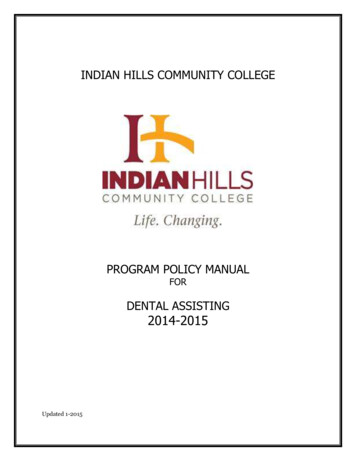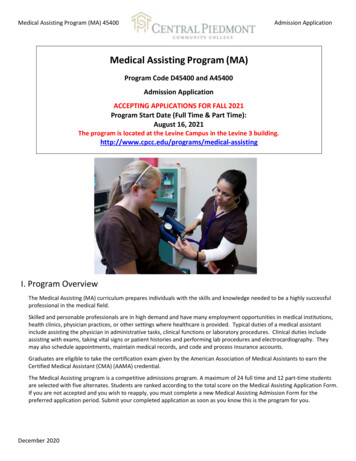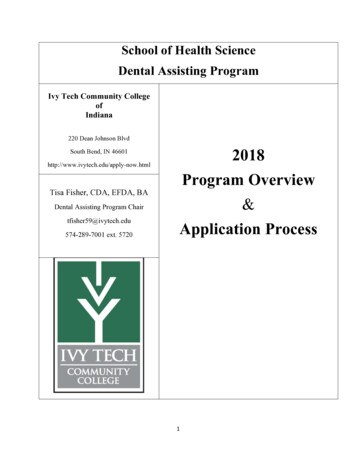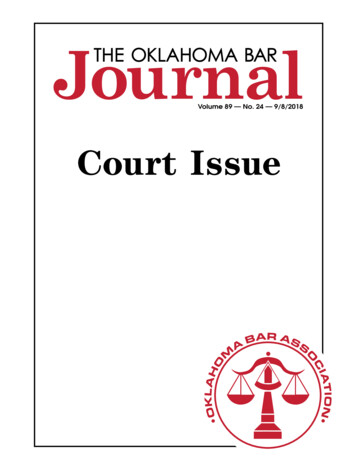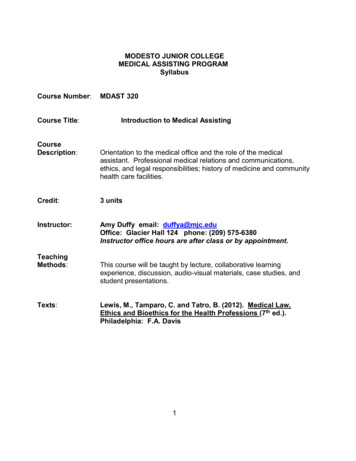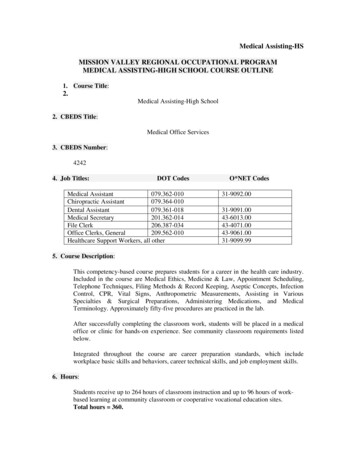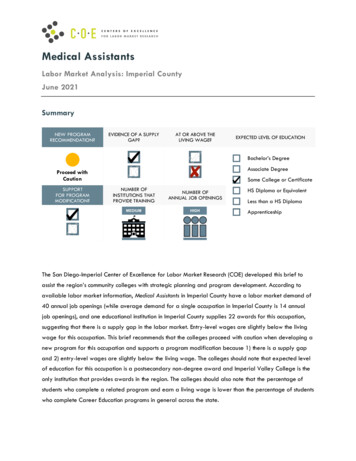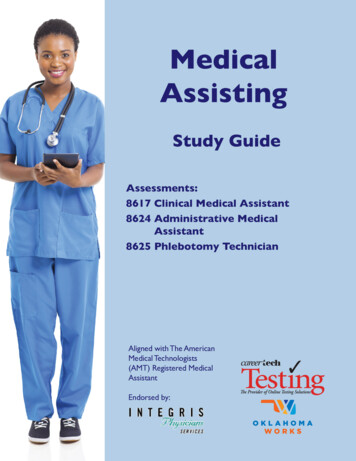
Transcription
MedicalAssistingStudy GuideAssessments:8617 Clinical Medical Assistant8624 Administrative MedicalAssistant8625 Phlebotomy TechnicianAligned with The AmericanMedical Technologists(AMT) Registered MedicalAssistantEndorsed by:
OverviewThis study guide is designed to help students prepare for the following Medical Assisting assessments:Clinical Medical Assistant, Administrative Medical Assistant, and Phlebotomy Technician. It not onlyincludes information about the assessments, but also the skills standards upon which the assessmentsare based and test taking strategies. The assessments measure a student’s ability to apply knowledge ofthe skills necessary for success in the Medical Assisting field.Each of the four sections in this guide provides useful information for students preparing the MedicalAssisting assessments. CareerTech and Competency-Based Education: A Winning Combination Medical Assisting Assessments Assessment Information Standards and Test Content Sample Questions Abbreviations, Symbols, and Acronyms Strategies for Test Taking Success NotesThe Clinical Medical Assistant assessment is aligned with The American Medical Technologists (AMT)Registered Medical Assistant and endorsed by INTEGRIS Physicians Services. The AdministrativeMedical Assistant assessment is aligned with the AMT Administrative Specialist and endorsed by theINTEGRIS Physicians Services. The Phlebotomy Technician assessment is aligned with AMT RegisteredPhlebotomy Technician and endorsed by INTEGRIS Physicians Services.American Medical Technologists (AMT) is a nationally and internationally recognized health certificationagency. AMT certification examinations are developed, administered, and analyzed using industrystandards and state-of-the-art methodologies. AMT is also one of the few health care certificationorganizations accredited by the National Commission for Certifying Agencies (NCCA).www.americanmedtech.orgINTEGRIS Health Inc. is a not-for-profit corporation and is Oklahoma’s largest health care system. Itwas organized for charitable, scientific and educational purposes and to engage in the delivery of healthcare services and other related activities.www.integrisok.comDisclaimerThe Oklahoma Department of Career and Technology Education cannot vouch for the accuracy of the information contained inany linked site. Our intent is to simply provide a list of sites that we feel may be useful to you. Some of the links presented here arecommercial sites. We do not endorse these sites or their products, and we do not request or accept any fee for inclusion on this list. TheDepartment makes no representations or warranties, express or implied, with respect to the document, or any part thereof, includingany warrantees of title, noninfringement of copyright or patent rights of others, merchantability, or fitness or suitability for any purpose.Equal Opportunity/Non Discrimination StatementThe Oklahoma Department of Career and Technology Education does not discriminate on the basis of race, color, national origin,sex/gender, age, disability, or veteran status. Inquiries concerning application of this policy may be referred to the ODCTE ComplianceCoordinator, 1500 W. 7th Ave. Stillwater, OK 74074-4364, or call 1-800 522-5810 or (405) 377-2000.2
CareerTech and Competency-Based Education:A Winning CombinationCompetency-based education uses learning outcomes that emphasize both the application and creationof knowledge and the mastery of skills critical for success. In a competency-based education system,students advance upon mastery of competencies, which are measurable, transferable outcomes thatempower students.Career and technology education uses industry professionals and certification standards to identifythe knowledge and skills needed to master an occupation. This input provides the foundation fordevelopment of curriculum, assessments and other instructional materials needed to prepare studentsfor wealth-generating occupations and produce comprehensively trained, highly skilled employeesdemanded by the work force.Tools for SuccessCareerTech education relies on three basic instructional components to deliver competency-basedinstruction: skills standards, curriculum materials, and competency assessments.Skills standards provide the foundation for competency-based instruction and outline theknowledge and skills that must be mastered in order to perform related jobs within an industry. Skillsstandards are aligned with national skills standards and/or industry certification requirements; therefore,a student trained to the skills standards is equally employable in local, state and national job markets.Curriculum materials and textbooks contain information and activities that teach studentsthe knowledge and skills outlined in the skills standards. In addition to complementing classroominstruction, curriculum resources include supplemental activities that enhance learning by providingopportunities to apply knowledge and demonstrate skills.Certification Assessments test the student over material outlined in the skills standards andtaught using the curriculum materials and textbooks. When used with classroom performanceevaluations, certification assessments provide a means of measuring occupational readiness.ess.Each of these components satisfies a unique purpose in competency-based education and reinforces theknowledge and skills students need to gain employment and succeed on the job.Measuring SuccessEvaluation is an important component of competency-based education. Pre-training assessmentsmeasure the student's existing knowledge prior to receiving instruction and ensure the student'straining builds upon this knowledge base. Formative assessments administered throughout the trainingprocess provide a means of continuously monitoring the student's progress towards mastery.Certification assessments provide a means of evaluating the student’s mastery of knowledge and skills.Coaching reports communicate assessment scores to students and provide a breakdown of assessmentresults by standard area. The coaching report also shows how well the student has mastered skillsneeded to perform major job functions and identifies areas of job responsibility that may requireadditional instruction and/or training.3
Medical AssistingAssessment InformationWhat are the Medical Assisting assessments?The Clinical Medical Assistant assessment, Administrative Medical Assistant assessment, andPhlebotomyTechnician assessment are end-of-program assessments for students in Medical Assistingprograms. The assessments provide an indication of student mastery of knowledge and conceptsnecessary for success in careers in this area.How were the assessments developed?The assessments were developed by the CareerTech Testing Center. The Clinical Medical Assistantassessment is aligned with AMT Registered Medical Assistant and endorsed by INTEGRIS PhysiciansServices. The Administrative Medical Assistant assessment is aligned with the AMT AdministrativeSpecialist and endorsed by the INTEGRIS Physicians Services. The Phlebotomy Technician assessmentis aligned with AMT Registered Phlebotomy Technician and endorsed by INTEGRIS Physicians Services.Items were developed and reviewed by a committee of subject matter experts.What do the assessments cover?Specifically, the test includes multiple-choice test items over the following areas:Clinical Medical Assistant (100 questions)Display ProfessionalismApply Communication SkillsPerform Clinical DutiesApply Legal, Ethical, and Confidentiality ConceptsProvide Patient Instruction10%8%61%11%10%Administrative Medical Assistant (85 questions)Medical Assisting FoundationsBasic Clinical Medical Office AssistingMedical Office Clerical AssistingMedical Records ManagementHealth Care Insurance Processing, Coding, and BillingMedical Office Financial ManagementMedical Office Information ProcessingMedical Office Management13%4%11%11%17%14%8%22%4
Phlebotomy Technician (75 questions)Obtaining Blood SamplesSpecimen Collection and ProcessingTime Management and Assignment OrganizationProfessional CommunicationsClerical Skills and DutiesSafety Standards and ProceduresLegal, Ethical, and Professional ConsiderationsTerminology,Anatomy, and Physiology41%7%9%3%5%15%9%11%What are the benefits of using these assessments?Students receive a certificate for each assessment that he/she passes. This certificate may be includedin his/her portfolio and used to communicate the student’s mastery of the subject matter to potentialemployers.When should the assessment be taken?The CareerTech Testing Center recommends that students take the assessments as soon as possibleafter receiving all standards-related instruction, rather than waiting until the end of the school year.Are the assessments timed?No. However, most students finish the assessment within one hour.What resources can students use on these assessments?Students are allowed to use calculators and scratch paper on CTTC assessments; however, these itemsmust be provided by the testing proctor and returned to the proctor before the student’s exam issubmitted for scoring. Calculator apps on cell phones and other devices may not be used on theseassessments.What accommodations can be made for students withIndividualized Education Plans (IEPs)?Accommodations are allowed for students with an Individualized Education Plan. Examples of allowableaccommodations include: Extended time — This assessment is not timed; therefore, students may take as much time asneeded to finish. The assessment must be completed in one testing session. Readers — A reader may be used to read the assessment to a student who has been identified asneeding this accommodation. Enlarged text — Students needing this accommodation can activate this feature by clicking theicon in the upper right corner of the screen.5
What can students expect on Test Day?All CTTC assessments are web-based and delivered exclusively by a proctor in the school’s assessmentcenter. The proctor cannot be an instructor or anyone who was involved with the student duringinstruction.Assessments are delivered in a question-by-question format. When a question is presented, the studentcan select a response or leave the question unanswered and advance to the next question. Studentsmay also flag questions to revisit before the test is scored. All questions must be answered before thetest can be submitted for scoring.After the assessment is scored, the student will receive a score report that not only shows the student’sscore on the assessment, but also how the student performed in each standard area.Can students retake the test?Students may retake the test unless their school or state testing policies prohibit retesting. Studentswho can retest must wait at least three days between test attempts.6
Standards and Test ContentClinical Medical AssistantDisplay Professionalism (10 questions)1. Project a positive attitude Anticipate and respond to the needs ofothers Display a sincere interest in providingappropriate information Enforce positive perceptions andovercome negative perceptions Act as a role model for holistic health Display a professional image and dress‣ B usiness dress, posture, personal habits,gestures‣ Hygiene (hair, cleanliness, make-up)‣ Etiquette (table manners, gum,handshakes, introductions, etc.)2. Demonstrate ethical behavior3. Practice within the scope of education,training and personal capabilities Determine personal capabilities and performance limitations Recognize and function within personal limitations4. Maintain Confidentiality Maintain confidentiality of verbal, written, and computer information5. Work as a team member Display awareness of own and other team members’ responsibilities (physicians, other office staff)Interact with others in a supportive mannerPractice the techniques of successful group dynamics and team buildingKnowledge of work process (how to recognize what and why other staff need information)6. Conduct oneself in a courteous and diplomatic manner Interact with others in a polite, cordial manner Abide by geographic and cultural customs of courtesy Use communication techniques such as non-aggressive language and active listening7. Adapt to change Assess the type of conflict that is occurring Confront the issues and people involved to resolve the conflict Apply problem solving skills to:‣ Prioritize needs‣ Adapt schedules‣ Reassign duties‣ Modify activities‣ Revise procedures7
8. Show initiative and responsibility Attend work regularly and arrive on timePerform tasks properly, completely, and accuratelyAccept responsibility for own actions; admit errors and assist in correctionsRecognize the work to be done and offer assistanceVolunteer for additional duties as time allowsSet and achieve self-development goals‣ Educational needs‣ Professional goals‣ Personal goals Recognize community organizations9. Promote the Profession Maintain and encourage professional membership at the local, state, and national level (AmericanAssociation of Medical Assistants, Professional Secretaries International,Vocational StudentOrganizations) Participate in professional meetings, seminars, workshops, and community events‣ Attendance‣ Sponsorship‣ Presentations Project the concept of the professional medical assistant10. Apply critical thinking skills to workplace situations Utilize quality performance processes Utilize tools to analyze information‣ Basic statistical concepts and analysis, create charts, histograms, flow charts, quality tools11. Manage stress Identify factors that cause stress In-house and outside resources Basic ways to reduce stress (diet, exercise) Separating home and work stressApply Communication Skills (8 questions)1. Listen and observe Use listening and understanding techniques to determine key ideas for each of the following‣ Patients‣ Business Contacts‣ Family members‣ Observe to identify needs of others‣ Team members2. Treat all patients with empathy and impartiality Display empathic behavior in patient relationships‣ Identify verbal and nonverbal cues that express feelings, emotions, and needs‣ Interact with patients in such a manner as to encourage them to express feelings, emotions,and needs8
Display impartial behavior‣ Identify personal bias and prejudice‣ Recognize and respond appropriately to cultural differences3. Adapt communication to individual’s abilities to understand Identify patients with special needs Use appropriate responses to communicate with patients with specialneeds4. Recognize and respond to verbal and nonverbal communication Select appropriate response to verbal messages Select appropriate response to nonverbal messages by‣ Giving support through positive body language‣ Exhibiting active listening skills‣ Overcoming obstacles to nonverbal communication5. Serve as liaison between physician and others Identify the professional roles of allied health care providers Recognize professional licensure/certification credentials Respond in professional situations in a manner that enhances the stature of the physician/employer6. Evaluate understanding of communication Determine if the receiver understood intent and content of the communications by:‣ Practicing active listening‣ Paraphrasing statements‣ Questioning for clear interpretation‣ Observing responses7. Receive, organize, prioritize, and transmit information In person By telephoneBy mail By memoBy FaxBy computer (i.e., electronic mail, Internet)Utilize appropriate confidentiality release and transmittal procedures (including HIPAA Privacy Rule)Organize and prioritize incoming information8. Use proper telephone technique Project positive telephone image Handle incoming telephone calls as follows:‣ Receive incoming calls‣ Manage multiple incoming calls‣ Screen incoming calls‣ Utilize telephone log or computerized system‣ Transfer incoming calls when indicated Handle the following telephone calls:‣‣‣‣‣‣Appointments for patients‣ Requests for referralsInquiries about bills‣ Receiving X-ray or lab reportsRequests about fees‣ Requests for insurance assistanceSatisfactory progress reports from patients or family membersRoutine reports from hospitals and other sourcesOffice administration matters9
Handle telephone calls involving special problems‣ Unidentified callers‣ Angry callers‣ Calls from family and friends‣ Callers who will not end the call Handle telephone calls involving medical emergencies Record and deliver accurate telephone message Organize and place outgoing telephone calls‣ Local‣ Conference‣ Long distance Utilize special features, if available Identify factors that relate to a global business environment‣ Time zones‣ International dialing codes‣ Mailing Use telephone directories‣ Directory—types and organization‣ Company directory maintenance‣ Telephone assistance and information9. Interview effectively Patient by telephone Patient in office Family member by telephone Family member in office Supplier/pharmaceutical representative10. Use medical terminology appropriately Build and define medical terms Select and use appropriate terminology in the following:‣ Transcription‣ Patient education‣ Reports‣ Correspondence‣ Records and documents Utilize technical references to verify accuracy‣ Spelling11. Compose written communication using correct grammar, spelling, and format Select and use appropriate format for written communication Use reference materials‣ Dictionary‣ Thesaurus‣ Secretarial reference manuals‣ Gregg’s Reference Manual‣ Software/hardware documentation‣ Microsoft Office Spell Check10
Perform Clinical Duties (62 questions)1. Apply principles of aseptic technique Perform medical aseptic procedures‣ Handwashing‣ Sanitize instruments‣ Chemical disinfection of articles‣ Work environment Perform surgical aseptic procedures‣‣‣‣‣‣‣‣‣Wrap and autoclave an articlePerform a surgical scrubUtilize transfer forcepsOpen a sterile packSet up a sterile trayApply and remove sterile glovesPerform a sterile dressing changeAssist with minor office surgeryRemove sutures2. Apply principles of infection control Orientation and documentation of blood-borne pathogens Process all specimens in a manner that eliminates or reduces the transmission of disease Maintain an environment that eliminates or reduces transmission of disease Dispose of specimens and equipment in accordance with federal, state, and local guidelines(CDC, OSHA)3. Take vital signs Body temperature‣ Take and record oral temperature‣ Take and record rectal temperature‣ Take and record axillary temperature Pulse‣ Take and record radial pulse‣ Take and record apical pulse Respiration‣ Take and record respiration Blood pressure‣ Take and record blood pressure4. Recognize emergencies Distinguish between emergency and non-emergency situations Apply assessment techniques to:‣ Perform telephone assessment‣ Prepare for an emergency‣ Perform visual assessment5. Perform first-aid and CPR Administer first-aid‣‣‣‣‣‣Control bleeding‣ Treat seizuresApply bandages‣ Treat for poisoningTreat for shock‣ Treat for burnsImmobilize fractures‣ Treat diabetic emergenciesTreat syncopeTreat central nervous system injuries and disorders11
Administer CPR‣‣‣‣Remove airway obstructionsAdminister artificial ventilationAdminister chest compressions Perform abdominal thrust on a conscious adult,child, or infant when choking6. Prepare and maintain examination and treatment area Ensure cleanliness Check equipment for proper working order andsafety Assemble equipment for examination/treatment Remove used items from examination/treatmentroom Restock supplies in examination/treatment area Observe safety precautions7. Interview and take patient history Complete a patient history Interview the patient to obtain patient history data Record patient history8. Prepare patients for procedures Instruct patients in preparation for examinations and procedures‣ Routine physical exams‣ Specialty exams Position and drape patient in the following positions:‣ Horizontal recumbent‣ Dorsal recumbent‣ Sim’s‣ Knee-chest‣ Dorsal lithotomy Prepare and/or secure patient’s written consent as required Instruct and inform patients in preparation for procedures and examinations Apply principles of radiation safety if assisting with radiographic procedures‣ Wear dosimetry badge‣ Protect patient from undue exposure Provide post-procedure instructions9. Assist physician with examinations and treatments Explain procedures to patient Prepare supplies for procedures and treatments Assist physician with examinations and treatments‣ Anticipate needs of physician‣ Chart procedures‣ Provide patient with instructions‣ Clean examination/treatment room12
10. Use quality control Use quality control principles during:‣ Patient preparation‣ Specimen collection and handling‣ Reagent management‣ Instrument calibration‣ Laboratory testing‣ Diagnostic testing Prepare/maintain quality control log book‣ Record quality control data‣ Maintain records of quality control data11. Collect and process specimens Complete a laboratory request formInstruct patient in specimen collectionPrepare equipment/supplies for collectionCollect and label biological specimen‣ Blood Venipuncture Capillary puncture‣ Urine Clean catchTimedRandomMidstream‣ Stool‣ Sputum‣ Throat culture‣ Vaginal Process specimens after collection Prepare/fix specimen for examination Deliver specimens for laboratory testing Dispose of specimens and collection equipment12. Perform selected tests that assist with diagnosis and treatment Perform a routine urinalysis and record results‣ Physical‣ Microscopic‣ Chemical Perform hematologic tests and record results‣ Hematocrit‣ Hemoglobin RBCWBCPlatelet count‣ Differential white blood cell count Perform blood chemistry testing and record results‣ Glucose (FBS, GTT)‣ BUN‣ Erythrocyte sedimentation rate‣ Blood cell counts‣ Cholesterol‣ Triglycerides13
13. Perform immunological tests and record results Mono tests Strep screen Rh factor Pregnancy tests Allergy scratch tests14. Perform microbiological tests and record results Streptococcal testingUrine cultureWound cultureVaginal cultures Gram staining Sensitivity testing Sensitivity testing15. Perform tuberculosis screen and record results Tine Mantoux16. Run an electrocardiogram and record results 12-lead Rhythm strip17. Perform vision testing and record results Distance visual acuity Near visual acuity Color blindness18. Screen and follow up patient test results Alert physician/supervisor of abnormal test results Upon physician’s orders:‣‣‣‣Discuss test results with patientInstruct patient on diet modificationInstruct patient on drug dosage modificationSchedule patient for:— Hospitalization— Surgery— Return office visit— Other physicians— Physical therapy— Other treatments19. Prepare and administer medications as directed by physician Select the proper medication to administer Calculate a drug dosage Prepare the medication‣‣‣‣‣Transfer oral medication to medicine cupReconstitute a powdered drugWithdraw parenteral medication for an ampuleWithdraw parenteral medication from a vialPrepare a unit-dose cartridge syringe Administer medication and record the procedure‣‣‣‣‣‣‣‣Oral solid medicationOral liquid medicationIntradermal injectionSubcutaneous injection14Intramuscular injectionTopical medicationEye dropsEar drops
20. Maintain medication records Record medication given Write a prescription for physician signature Maintain a controlled substance log book21. Utilize proper body mechanics22. Apply basic math to medically related problems Patient weight Add, subtract, multiply, divide. Compute cost of supplies used (student used 4 foley catheters and theycost X each – so compute patient charges) Inventory/supply problem (Suzanne knows of problem-in Keir Med Asst test) Compute cost of day in a health care facility23. Interpret diagrams, charts, graphs, and tables Table of conversionsTemperature or weight graphsX/y growth chartsRule of ninesHousehold-metric-apothecary equivalents (table)24. Convert household, apothecary and metric measures25. Use formulas and equations to solve health-related math problems. Metric to U.S. and U.S. to metric; ratio and proportions Solving for X (prep for dosage calculations)26. Transfer and transport patients with or without assistive devices using properbody mechanics Operate wheelchairAssist clients/patients with ambulation. (crutches, canes, walkers, and gait belts)Provide transfer assistance to patients/clientsWheelchair, chair, bedside commode, stretcher, bedApply Legal, Ethical, and Confidentiality Concepts (11 questions)1. Document accurately Accurately document medical information Appropriately correct medical information entries2. Determine needs for documentation and reporting Identify sources of information for medicolegal documentation requirements in given localityObserve local, state, and federal guidelines for statutory reportsAbide by reporting/documentation procedures for DEAFulfill IRS guidelines for reports and documentationObtain employment guidelines from appropriate agency and complyDocument medical records and complete incident report promptly for all personal injury occurrencesComply with workers’ compensation reporting requirementsDocument all activity related to patient care in the medical record15
3. Use appropriate guidelines when releasing records or information Protect privacy and confidentiality of patient health information Release information in accordance with federal and state regulations‣‣‣‣‣‣Basic right to privacyDrug and alcohol rehabilitation recordsPublic health and welfare disclosuresRights of minorsHIV-related issuesSubpoena duces tecum/depositions/court orders Release information in response to written patient authorization Honor a patient request to rescind an authorization to release information4. Follow established policy in initiating, withdrawing, withholding, or terminating medical treatment Health care provider/physician/patient contract (offer, acceptance,consideration) Knowledge of the elements to be included in a letter ofwithdrawal Certified mail and return receipt Advance directives/Do Not Resuscitate Organ donations5. Dispose of controlled substances in compliance with governmentregulations Identify controlled substances and their schedules Comply with DEA regulations6. Maintain licenses and accreditation7. Monitor legislation related to current health care and practice8. Perform within ethical boundaries Apply ethical standards in the workplace Respect patient rights Recognize practices which involve bioethical issuesProvide Patient Instruction (9 questions)1. Orient patients of office policies and procedures Provide maps or verbal instructions on locationIntroduce office personnelProvide written and verbal information on office policiesAnswer questions within scope of training and educationUse patient education systems and literature2. Instruct patients with special needs Instruct and demonstrate routine procedures for monitoring body functions Instruct and demonstrate safety procedures for home medical equipment16
Demonstrate care, use, and special equipment to patient‣ Crutches‣ Braces‣ Walker‣ Splints‣ Cane‣ Casts‣ Wheelchairv‣ Slings‣ Hearing aids‣ Prosthetic appliances Provide written and verbal instructions on chronic disease conditions, as instructed by the physician3. Teach patients methods of health promotion and disease prevention Provide verbal and written information about routine physical examinations and laboratory testing4. Provide verbal and written information Nutrition and diet therapyExercise and weight controlHygieneSexually transmitted/communicable diseases and preventive measuresFamily planningSmoking cessationAlcohol/drug prevention and treatmentInstruct and assist patients with performance of self breast examinationsRefer patients to outside resources as instructed by the physician5. Orient and train personnel Introduce office staff Orientation to facility Assisting in the completion of personnel documents Distribute job descriptions Assign work schedule Make daily work assignments Demonstrate use of procedure manuals for the office Demonstrate use of policy manuals for the office Demonstrate use of office equipment Provide information on CDC Universal precautions, OSHA and CLIA, HIPAA, and AmericanDisabilities Act regulation Emergency preparedness plan17
Standards and Test ContentAdministrativeMedical Assisting Foundations (11 questions)1. Medical terminology Use and spell basic medical terms appropriately Identify root words, prefixes, and suffixes Define basic medical terms2. Anatomy and physiology Know basic structures and functions of body systems Know various disorders of the body (diseases, conditions,syndromes)3. Legal and ethical considerations Apply principles of medical law and ethics to the health caresetting Recognize legal responsibilities of, and know scope ofpractice for the medical administrative specialist Know basic laws pertaining to medical practice Know and observe disclosure laws (patient privacy, minors,confidentiality, HIPPA) Know the principles of medical ethics established by the AMA Recognize unethical practices and identify ethical responses for situations in the medical office4. Professionalism Employ human relations skills appropriate to the health care setting Display behaviors of a professional medical administrative specialist Participate in appropriate continuing educationBasic Clinical Medical Office Assisting (3 questions)1. Basic health history interview Obtain preliminary health histories from patients2. Basic charting Chart patient information3. Vital signs and measurements Measure vital signs (te
This study guide is designed to help students prepare for the following Medical Assisting assessments: Clinical Medical Assistant, Administrative Medical Assistant, and Phlebotomy Technician. It not only includes information about the assessments, but also the skills standards upon which the assessments are based and test taking strategies.

